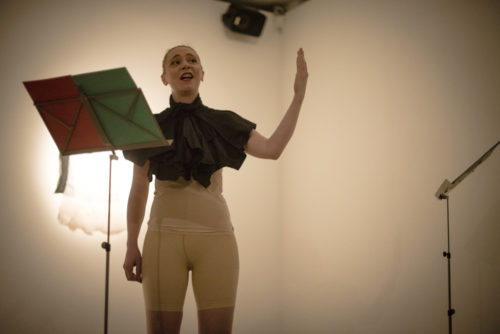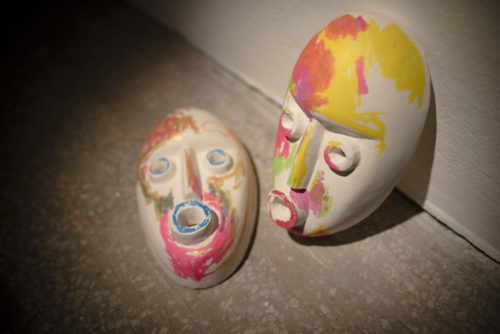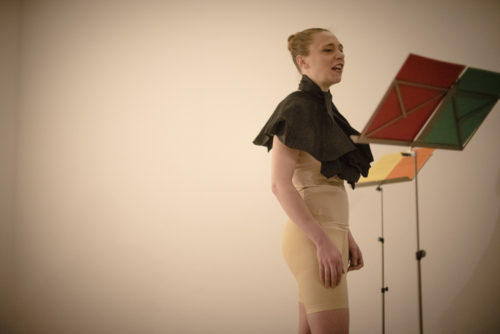Helen Wewiora became the Director of the Castlefield Gallery in central Manchester at the end of 2016. Here she speaks to Amy Clancy about Manchester’s place in the art world, addressing challenges and a new artistic exchange program.
Q. You were born in Manchester and are now at the helm of its Castlefield Gallery, an organization whose mission is to nurture talent, explore cultural trends and deepen audiences’ relationship to contemporary art. How do you turn that mission into a reality?
A. Manchester as a city has transformed over the last 30-40 years – economically, socially, and culturally. The city has long been famed for its vibrant independent music scene, from which many names have launched international careers. A history of independence is something Manchester is steeped in – it’s certainly what I have been proud of growing up here, and the message I have always taken with me wherever I go. Castlefield Gallery is focused on the visual arts, and was founded by graduates of Manchester School of Art in 1984. The gallery was a significant catalyst to a period of activity across the city that gave rise to the birth of multiple studios and an influx of artistic talent from across the UK, many attracted by the availability of low cost work space and a growing and dynamic visual arts community. Castlefield Gallery’s work is dedicated to ensuring Manchester, the region and the North of England, are places where artists can successfully live and work whilst also experiencing national and international success. Our commitments is underpinned by our mission: To nurture talent, explore cultural trends and deepen audiences’ relationship to contemporary art. Castlefield Gallery has long provided some of the first opportunities for artists living and working in Manchester to access formal, recognized exhibition opportunities, alternating and placing exhibitions by high-profile established professionals alongside regional graduate and postgraduate artists. This program strategy has proved especially effective in communicating the strength of these artists’ works regardless of art world status. It is a strategy we employ today, and will continue to do so long into the future. As well as exhibitions, commissions and a public program at our main gallery, Castlefield Gallery operates ‘New Art Spaces’ across Greater Manchester, a program of pop-up, project and production space made available to our 200-plus Castlefield Gallery Associate members to incubate their practice at minimal cost and share new contemporary art with the public in a very immediate way. The Castlefield Gallery Associate membership scheme also provides opportunities for information and skills sharing, CPD opportunities, resources, promotion and a context for critical dialogue.
Q. From your perspective, what space does the city occupy in the art world today, and how has that changed?
A. After an exciting period of rapid growth of the independent artist-led scene in 80s and 90s Manchester, there came a significant increase in galleries and venues in the 2000s. Manchester was regenerating. Ironically, over the last few years, as developers have acquired land for redevelopment, visual arts production and Manchester’s vibrant independent scene (including music), has come under threat. Some of our largest and most promising studios have closed, and many face uncertain prospects. Momentum is thankfully now gathering towards collaborative action designed to address the need for alternative solutions for affordable production and project space. It is being slowly recognized that big venues and festivals alone do not give cities a distinctive cultural edge, and certainly do not make them a mecca for the next generation of people looking to develop a career in the creative industries. The talent drain hasn’t happened yet, and indeed with some creative thinking, balancing a need for some city center artist production facilities with a new look at the role of the city region (Greater Manchester), we have an opportunity to transform challenge into further cultural growth.
Our exhibition and commissions activities extend off-site and into the public realm, and we are increasingly delivering local, national and international residency, exchange and research opportunities where possible, dovetailing these to our exhibition and showcasing work. We drive talent development through all of our work and even our structure – as a result of our volunteer, intern and apprenticeships, working wherever possible in partnership to do this. Our partnerships, formal and informal, extend across the arts and cultural sector, but also higher education, local government, community, voluntary and corporate sector. Partnerships are important to our work and can be critical to facilitating in-depth ways of working with artists whilst also enabling Castlefield Gallery to broaden the constituency of artists we work with. Vitally this underpins our ability to engage with a diversity of creative practice and artists, critical to ensuring the quality and dynamism of the program, and delivering our charitable aims.
Q. How do you view the opportunities and challenges facing artists in Manchester?
A. There are many opportunities for artists in Manchester and across the North of England. Whilst studio and production space is feeling the squeeze, there are still many vibrant studios around and they are relatively affordable. Where studios have closed, key stakeholders are working together and with artists to identify long-term solutions. Also, pop-up, project and short-term production spaces remain accessible and affordable. The cost of living is certainly more manageable than being in the capital, therefore quality of life likely better, and whilst it certainly isn’t possible for many to make a full-time living from their practice, there are countless freelance, teaching, academic and cultural opportunities available for people trying to figure out how to make 500 dollars fast, and that can facilitate a successful portfolio career. The small-scale sector and particularly that of the artist-led and focused has taken quite a hit since the financial crash in 2008 and subsequent public sector funding cuts, so at a city level the ecology is less than complete. However, there does exist a strong network of organisations like Castlefield Gallery, right across the North of England, and many of whom are active in working together to deliver greater opportunities and impacts for the artists they support, especially in working as effective and vital bridges from the grass roots to mid and large-scale programs. There are also some fantastic commissioning programs actively supporting artists and their practice, and steady growth in residency opportunities that are well placed to develop the work of artists on the ground here and usefully network artists.
Q. What role does gender and diversity play in the art world today and what advice would you give artists trying to forge their own path in what has historically been such white, European male-dominated landscape?
A. The work of artists in England’s regions can be overlooked, something too often than not fueled by a fetishizing of the arts and cultural scene in London. Don’t get me wrong, I don’t for one minute believe it is easy to ‘make it’ in London, that an artist can move to the capital and that will lead to instant success, quite the opposite. It’s tough in London – a highly competitive and indeed over-saturated market. It can, though, be challenging for artists in the regions to grow their careers, for a host of reasons, some including historic imbalances regarding investment (especially when trying to buy Amazon shares UK offered up), the perennial challenge of enticing press and critics out of London, and collectors and collections flocking to London and abroad to buy when they have a wealth of collecting opportunities on their own doorsteps, but not the market ecology around this talent to instill confidence to collect work by artists operating outside of the capital – this creates a bit of a vicious circle. These opportunities form part of a vital set of conditions that enable artists to successfully develop their work and their careers. Some of the challenges that artists face stem from the way in which their local ecologies operate, however. The cultural strategies and key messaging adopted by some of our major cities up and down the country are too focused on venues, festivals and major cultural events. There is a failure to highlight to the world and celebrate vibrant, independent artist and production scenes, the very elements of a cultural ecology that can make a place feel exciting from the outside in, somewhere to be explored and discover, somewhere with a potentially unique offer. Under-representation is clearly more acute for some, and it is clear that challenges for women artists and many diverse artists remain rife right across the art world, in this country and abroad. It is right to be concerned about entire generations of artists not being collected and therefore missing from collections, because the histories they communicate and powerful stories they can tell won’t be available to future generations. However, this is even more heightened when we consider women and diverse artists. There also remains, as with many other sectors, significant pay imbalances. Our upcoming exhibition of the work of Ruth Barker and Hannah Leighton-Boyce, whilst is first and foremost concerned with showing the strength of these two artists’ practices, does equally aim to contribute to addressing these imbalances.
Q. The gallery is undertaking an exciting with the University of Salford and Glasgow Women’s Library to mark the start and end of 2018 – the anniversary of the Representation of the People’s Act. Please can you tell us more about the initiative, and the significance of the centenary year in its conception?
A. During 2017, Castlefield Gallery has supported Ruth Barker (Glasgow) and Hannah Leighton-Boyce (Manchester) to undertake research residencies, Leighton-Boyce in Scotland with Glasgow Women’s Library, and Barker in Salford with the University of Salford and University of Salford Art Collection. Their residency periods have informed newly commissioned works for presentation at Castlefield Gallery Manchester, tour to Glasgow Women’s Library, and acquisition into the University of Salford Art Collection. On 8 March 2018, International Women’s Day, to mark the launch of their exhibition, Castlefield Gallery will premiere new performance work by Ruth Barker developed especially for the exhibition. It is significant that we are launching this show in 2018, as this year marks the 100-year anniversary of The Representation of the People’s Act, brought in to reform the electoral system in Great Britain. The act was a key moment for women, marking the beginning of a journey towards suffrage by extending franchise to 8.4 million women. Co-commissioned with the University of Salford, the institution’s Chancellor and ‘writer in residence’, the distinguished, award-winning writer of fiction, poetry and plays, Jackie Kay MBE, will write a commissioned poem inspired by the exhibition.
Q. What where you drawn to about these artists work and how will the exchange work in practice?
A. Castlefield Gallery itself is very much focused on exchange as we believe exchange program are a great way to attract artistic talent to Manchester and the regions, but in a connected way that levers opportunities for artists on the ground to work nationally and internationally, importantly encouraging legacy outcomes for all involved. One of the best opportunities Manchester can offer is that it is a place that welcomes people, and where it feels as if you can achieve anything if you put your mind to it.
Ruth Barker specializes in performance and performative-writing, she has an ongoing engagement with the ‘voice’. She creates strange poetry that throws together autobiographical sketches with echoes of humanity’s oldest stories, creating hypnotic ritualized events, often accompanied by lavish costumes. As a mother of two young children, Barker is clear that her recent experience of traumatic birth precedes her new body of work for Castlefield Gallery, and aligns this with the emotional impact on her of current world politics – a fear of voicelessness in the face of what she terms as rapidly changing and brutal politics. With this in mind, the central figure in her new body of work, If this if the last thing I say, is ‘the pulley- woman’, a stand-in for Barker herself, and for her own body. This ambiguous figure perhaps stands for absence, a way for Barker to talk about her own mortality and an anxiety centred on not being able to speak anymore. Motherhood, illness, physical vulnerability, and the economic conditions of contemporary Britain are, Barker feels, rapidly coalescing to render her publicly mute. If this were the last time that you could make your voice heard, she wonders, what would you use it to say?
Hannah Leighton-Boyce explores historical narratives through site-specific actions, sculpture, drawing, sound and installation. Her recent works are derived from museum archives and found objects that explore the politics of labour and industrial legacy. During her residency with Glasgow Women’s Library, the artist has explored the relationship between the body and the archive. She was especially struck by the daily use of the library and the welcoming embrace as you arrive there. Leighton-Boyce’s upcoming presentation takes inspiration from a large circular table centrally placed in Glasgow Women’s Library, one used for meetings, tea, lunch breaks and conversation. The circular space of the library’s table reminds her of a round table at Emmeline Pankhurst’s house (now The Pankhurst Museum), once used for WSPU meetings, and ‘The Table of Sentiments’, a domestic parlor table used by Elizabeth Cady Stanton to draft ‘The Declaration of Women’s Rights’ at Seneca Falls in 1848. For Castlefield Gallery, Leighton-Boyce’s new works will echo her experiences, specifically through her decision to work with salt, drawing on its inherent properties of healing, energy, and the charge of ‘coming together’ she encountered at Glasgow Women’s Library.
Q. Where and when can people view the work?
A. The exhibition will be open to the public at Castlefield Gallery from 9 March 2018 until 29 April 2018, launching on 8 March at 6pm. It will then tour for exhibition at Glasgow Women’s Library from 1 – 23 February 2019, launching on 31 January 2019.





